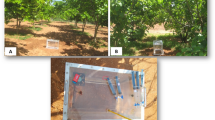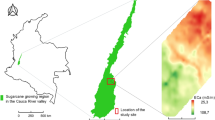Abstract
Quantification of greenhouse gas (GHG) emissions from agricultural lands is essential for strategic planning towards GHG efficient development in India. We measured the fluxes of CH4, N2O and CO2 during cultivation of two important crops; sugarcane and pigeon pea following the closed chamber technique. Both the soils acted as net CH4 sinks, but sources of N2O and CO2. Pigeon pea soil acted as a weak sink, removing 0.054 ± 0.002 kg CH4 ha−1 from the atmosphere, while sugarcane soil removed 11.061 ± 0.093 kg CH4 ha−1. Urea application in sugarcane field increased the fluxes of N2O, but the total N2O emission over growth period of sugarcane (355 days) was similar to the total emissions during pigeon pea cultivation (245 days); 2.69 ± 0.09 and 2.07 ± 0.17 kg N2O ha−1, respectively. CO2 fluxes from pigeon pea cultivation were higher than sugarcane cultivation. Pigeon pea cultivation was a low input farming, but its global warming potential was higher than that of sugarcane cultivation. This study presents the GHG estimates from cultivation of the two important crops in India for which GHG estimates are lacking.





Similar content being viewed by others
References
Adviento-Borbe MAA, Haddix ML, Binder DL, Walters DT, Dobermann A (2007) Soil greenhouse gas fluxes and global warming potential in four high-yielding maize systems. Glob Change Biol 13:1972–1988
Baggs EM, Stevenson M, Pihlati M, Regar A, Cook H, Cadisch G (2003) Nitrous oxide emissions following application of residues and fertilizer under zero and conventional tillage. Plant Soil 254:361–370
Bhatia A, Pathak H, Jain N, Singh PK, Singh AK (2005) Global warming potential of manure amended soils under rice–wheat system in the Indo-Gangetic plains. Atmos Environ 39:6976–6984
Contosta AR, Frey SD, Cooper AB (2011) Seasonal dynamics of soil respiration and N mineralization in chronically warmed and fertilized soils. Ecosphere. doi:10.1890/ES10-00133.1
Denmead OT, Macdonald BCT, White I, Reilly R, Kinsela A, Melville MD, Griffith DWT, Bryant G (2005) Acid sulfate soils: a new source of sulfur- and greenhouse-gases. In: Proceedings of the 4th International symposium on non-CO2 greenhouse gases (NCGG-4) science, control, policy and implementation, Utrecht, The Netherlands, 4–6 July, 2005. Millpress, Rotterdam, pp. 169–177
Denmead OT, Macdonald BCT, Naylor T, Wang W, Salter B, White I, Wilson S, Griffith DWT, Moody P (2008) Whole-of-season greenhouse gas emissions from Australian sugarcane soils. Proc Aust Soc Sugar Cane Technol 30:105–114
Denmead OT, Macdonald BCT, Bryant G, Naylor T, Wilson S, Griffith DWT, Wangd WJ, Salter B, White I, Moody PW (2010) Emissions of methane and nitrous oxide from Australian sugarcane soils. Agric For Meteorol 150:748–756
Department of Agriculture Fisheries and Forestry (2013) Guidance for on-farm measurement of agricultural greenhouse gas emissions and soil carbon. Government of Australia, Canberra
Dickman SR, Bray RH (1940) Colorimetric determination of phosphate. Ind Eng Chem Anal Ed 12:665–668
Directorate of Sugarcane Development (2013) Status paper on sugarcane. Government of India, Lucknow 16
Ellert BH, Janzen HH (2008) Nitrous oxide, carbon dioxide and methane emissions from irrigated cropping systems as influenced by legumes, manure and fertilizer. Can J Soil Sci 88:207–217
FAO (2006). http://faostat.fao.org/
Ghosh S, Majumdar D, Jain MC (2002) Nitrous oxide emissions from kharif and rabi legumes grown on an alluvial soil. Biol Fertil Soils 35:473–478
GoI (2009) National policy on biofuels. Government of India, Ministry of New & Renewable Energy, New Delhi
Graham PH, Vance CP (2000) Nitrogen fixation in perspective: an overview of research and extension needs. Field Crop Res 65:93–106
Gregorich EG, Drury CF, Baldock JA (2000) Changes in soil carbon under long-term maize in monoculture and legume-based rotation. Can J Soil Sci 81:21–31
Hansen S, Maehlum JE, Bakken LR (1993) N2O and CH4 fluxes in soil influenced by fertilization and tractor traffic. Soil Biol Biochem 25:621–630
Hutsch BW, Webster CP, Powlson DS (1993) Long term effects of nitrogen fertilization on methane oxidation in soil of the Broadbalk wheat experiment. Soil Biol Biochem 25:1307–1315
Indian Network for Climate Change Assessment (2010) India: greenhouse gas emissions 2007. Ministry of Environment and Forests. Government of India, New Delhi
IPCC Climate Change (2007) Synthesis report: contribution of working groups I II and III to the fourth assessment report. Intergovernmental Panel on Climate Change, Geneva
Lal R (2004) Soil carbon sequestration impacts on global climate change and food security. Science 304(11):1623–1627
Le Mer JL, Roger P (2001) Production, oxidation, emission and consumption of methane by soils: a review. Eur J Soil Biol 37:25–50
Linquist B, Van Groenigen KJ, Adviento-Borbe MA, Pittelkow C, Van Kessel C (2012) An agronomic assessment of greenhouse gas emissions from major cereal crops. Glob Change Biol 18:194–209
Liu X, Liu H, Zhao P, Sun G, Lin Y, Rao X, Wang Y (2007) Characteristics of CO2, CH4 and N2O emissions from winter-fallowed paddy fields in hilly areas of South China. Front Agric China 1(4):418–423
Macedo MO, Resende AS, Garcia PC, Boddey RM, Jantalia CP, Urquiaga S, Campello EF, Franco AA (2008) Changes in soil C and N stocks and nutrient dynamics 13 years after recovery of degraded land using leguminous nitrogen-fixing trees. For Ecol Manag 255:1516–1524
Murphy D, Mc Candless M, Drexhage J (2010) Expanding agriculture’s role in the international climate change regime: capturing the opportunities. International Institute for Sustainable Development, Winnipeg
Olsen SR, Cole CV, Watanabe FS, Dean LA (1954) Estimation of available phosphorous in soils by extraction with sodium bicarbonate. USDA Circular
Pandey D, Agrawal M, Bohra JS (2012) Greenhouse gas emissions from rice crop with different tillage permutations in rice-wheat system. Agric Ecosyst Environ 159:133–144
Pandey D, Agrawal M, Bohra JS (2013) Impact of four tillage permutations in rice–wheat system on GHG performance of wheat cultivation through carbon footprinting. Ecol Eng 60:261–270
Robertson GP, Paul EA, Harwood RR (2000) Greenhouse gases in intensive agriculture: contributions of individual gases to the radiative forcing of the atmosphere. Science 289:1922–1925
Rochette P, Janzen HH (2005) Towards a revised coefficient for estimating N2O emissions from legumes. Nutr Cycl Agroecosyst 73:171–179
Rosen A, Lindgren PE, Ljunggren H (1996) Denitrification by Rhizobium meliloti 1. Studies of free-living cells and nodulated plants. Swed J Agric Res 26:105–113
Sahrawat KL, Keeney DR (1986) Nitrous oxide emission from soils. Adv Soil Sci 4:103–148
Saxena KB (2008) Genetic improvement of pigeon pea—a review. Trop Plant Biol 1:159–178
SwamiYV Nikhil GN, Venkanna R (2012) Emission of methane and nitrous oxide from Vigna mungo and Vignaradiata legumes in India during the dry cropping seasons. Atmósfera 25:107–120
Thenkabail PS, Hanjra MA, Dheeravath V, Gumma M (2010) A holistic view of global croplands and their water use for ensuring global food security in the 21st century through advanced remote sensing and non-remote sensing approaches. Remote Sens 2:211–261
Vance CP (2001) Symbiotic nitrogen fixation and phosphorus acquisition. plant nutrition in a world of declining renewable resources. Plant Physiol 127:390–397
Walkley A, Black IA (1947) A critical examination of a rapid method for determining organic carbon in soils: effect of variations in digestion conditions and of organic soil constituents. Soil Sci 63:251–263
Weier KL (1996) Trace gas emissions from a trash blanketed sugarcane field in tropical Australia. In: Wilson JR, Hogarth DM, Campbell JA, Garside AL (eds) Sugarcane: research towards efficient and sustainable production. CSIRO Division of Tropical Crops and Pastures, Brisbane, pp 271–272
Weier KL (1998) Sugarcane fields: sources or sinks for greenhouse gas emissions? Aust J Agric Res 49:1–9
Weier KL (1999) N2O and CH4 consumption in a sugarcane soil after variation in nitrogen and water application. Soil Biol Biochem 31:1931–1941
West TO, Post WM (2002) Soil organic carbon sequestration rates by tillage and crop rotation: a global data analysis. Soil Sci Soc Am J 66:1930–1946
Acknowledgments
Divya Pandey is thankful to the National Academy of Sciences, India and Prof. Manju Sharma, Distinguished Woman Scientist Chair, National Academy of Sciences, India for research fellowship. Authors are thankful to the University Grants Commission, India for financial help in the form of a research project (P-01/689).
Conflict of interest
There was no conflict of interest.
Author information
Authors and Affiliations
Corresponding author
Rights and permissions
About this article
Cite this article
Pandey, D., Agrawal, M. Greenhouse Gas Fluxes from Sugarcane and Pigeon Pea Cultivated Soils. Agric Res 4, 245–253 (2015). https://doi.org/10.1007/s40003-015-0166-6
Received:
Accepted:
Published:
Issue Date:
DOI: https://doi.org/10.1007/s40003-015-0166-6




